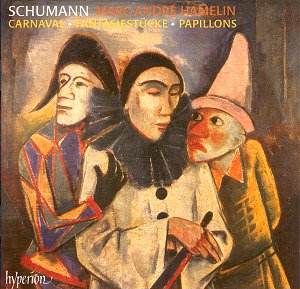Carnaval (Schumann)
Carnaval, Opus 9 is an existing of short character pieces piano cycle by Robert Schumann.
Background
The Carnaval was created in 1834 / 1835. Preceded it was the engagement with Ernestine Schumann von Fricken, the adopted daughter of a Bohemian baron. Schumann broke off the engagement prior to one year. Nevertheless, he continued Ernestine with the Carnaval a musical monument. The fact of Frickens came from the Bohemian town of Asch; This place name is the cycle in the manner basis that Schumann transposed the letters A -Es- CH -CH and As as tones in the miniatures. The piece in a sense turns dansantes around the inserted in the middle part Lettres, which include the combination It -CHA belonged ( the single letter from Schumann's last name, which can be implemented as tones ). In the Sphinx, the tone sequences are "explained". The Sphinx will not play, they are merely hub: The first part is consistently (usually at the beginning of a thumbnail ) the pattern, A -Es- CH, -CH As the notation incorporated in the second half of the work on the pieces.
Actually, the work should get the German title " Carnival " in which stuck the tone letters A -Es- CH -CH or As. The subtitle should be " farces on four notes ". In the word " farce " can be found, as in " Schumann " It -CHA. Schumann but acquiesced to the wishes of the publisher. The title was the fashion of the Frenchified to Carnaval, Scènes mignonnes sur quatre notes.
A piece entitled Estrella ( Ernestine von Fricken Davidsbündlername ), one is Chiarina ( Davidsbündlername by Clara Schumann) dedicated, even the march of Davidsbündler against the Philistines as the crowning finale is not missing. The thumbnails with the titles of Chopin and Paganini are the exceptions in the characteristic style of notation described ( the tone sequences A -Es- CH or As -CH do not seem to ).
The miniatures
- Préambule: Quasi maestoso - Più moto - Animato ( - Vivo ) - Presto. Motif as- CH ( H listed as Ces ) in Animato -vivo part ( in the bass sforzato )
- Pierrot: Moderato. Motif A -Es- CH ( H = Ces ) in the bass ( piano), in contrast to E CB ( forte)
- Arlequin: Vivo. Motif A -Es- C, which effectively enhancing jumps in the upper voice
- Valse noble: Un poco maestoso. Motif A -Es- H -C
- Eusebius: Adagio - Più lento. Motif A -Es- C -H plays around with side-notes
- Florestan: Passionato. Motif A -Es- CH interrupted by adagio topics from the Papillons, Op 2
- Coquette: Vivo. Motif A -Es- CH processed in the topic in punctuations
- REPLIQUE: L' istesso tempo. Postscript to Coquette
- Sphinx. It motifs -CHA, As -CH and A -Es- CH, the note should not be played
- Papillons: Prestissimo. Motif A -Es- C -H ( H = Ces )
- A.S.C.H. - S.C.H.A. ( Lettres dansantes ): Presto. Scene As- C -H
- Chiarina: Passionato. Scene As- C -H
- Chopin: Agitato. Motive hidden at the end, in tune HC, As final note
- Estrella: Con affetto - Più presto. Scene As- C -H
- Reconnaissance: Animato. Motif as- CH, the melody is played in octaves in the right hand, in the lower position in sixteenth - staccato, in the upper layer into eighths
- Pantalon et Colombine: Presto. Scene As- C -H
- Valse allemande: Molto Vivace. Scene As- C -H
- Paganini: Presto. An interlude to Valse allemande. Virtuoso opposite and metric offset staccato semiquaver figures
- Aveu: Passionato. Scene As- C -H
- Promenade: Con Moto. Motif as- CH, op in # 3 of 6 Davidsbündlertänze transaction will give quotes a motif
- Break: Vivo. Resumption of Vivo part from the second part of the Préambule, motive as- CH ( H listed as Ces ) in vivo part ( in the bass sforzato )
- Marche des " Davidsbündler " contre les Philistins: Non Allegro - Molto più vivo - Animato - Vivo - Animato molto - Più stretto. Motif as- CH, quotes from the Papillons, Op 2 and moldings from the Préambule; radiant circuit.










